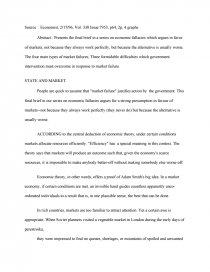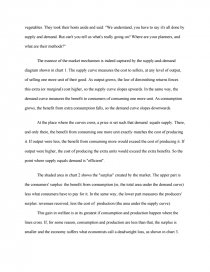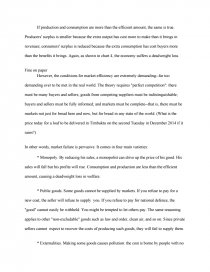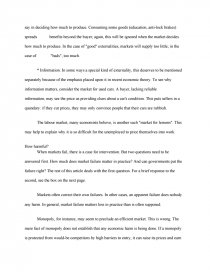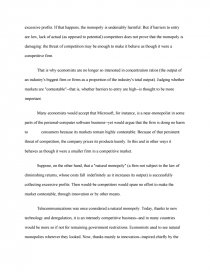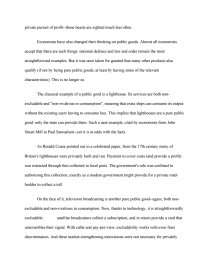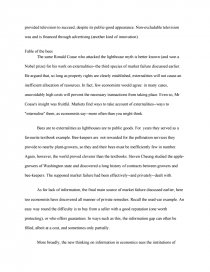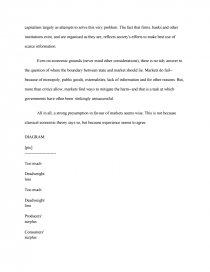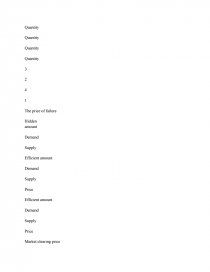State And Market
Essay by 24 • July 15, 2010 • 2,195 Words (9 Pages) • 2,748 Views
Source : Economist, 2/17/96, Vol. 338 Issue 7953, p64, 2p, 4 graphs
Abstract : Presents the final brief in a series on economic fallacies which argues in favor of markets, not because they always work perfectly, but because the alternative is usually worse. The four main types of market failures; Three formidable difficulties which government intervention must overcome in response to market failure.
STATE AND MARKET
People are quick to assume that "market failure" justifies action by the government. This final brief in our series on economic fallacies argues for a strong presumption in favour of markets--not because they always work perfectly (they never do) but because the alternative is usually worse.
ACCORDING to the central deduction of economic theory, under certain conditions markets allocate resources efficiently. "Efficiency" has a special meaning in this context. The theory says that markets will produce an outcome such that, given the economy's scarce resources, it is impossible to make anybody better-off without making somebody else worse-off.
Economic theory, in other words, offers a proof of Adam Smith's big idea. In a market economy, if certain conditions are met, an invisible hand guides countless apparently unco-ordinated individuals to a result that is, in one plausible sense, the best that can be done.
In rich countries, markets are too familiar to attract attention. Yet a certain awe is appropriate. When Soviet planners visited a vegetable market in London during the early days of perestroika,
they were impressed to find no queues, shortages, or mountains of spoiled and unwanted vegetables. They took their hosts aside and said: "We understand, you have to say it's all done by supply and demand. But can't you tell us what's really going on? Where are your planners, and what are their methods?"
The essence of the market mechanism is indeed captured by the supply-and-demand diagram shown in chart 1. The supply curve measures the cost to sellers, at any level of output, of selling one more unit of their good. As output grows, the law of diminishing returns forces this extra (or marginal) cost higher, so the supply curve slopes upwards. In the same way, the demand curve measures the benefit to consumers of consuming one more unit. As consumption grows, the benefit from extra consumption falls, so the demand curve slopes downwards.
At the place where the curves cross, a price is set such that demand equals supply. There, and only there, the benefit from consuming one more unit exactly matches the cost of producing it. If output were less, the benefit from consuming more would exceed the cost of producing it. If output were higher, the cost of producing the extra units would exceed the extra benefits. So the point where supply equals demand is "efficient".
The shaded area in chart 2 shows the "surplus" created by the market. The upper part is the consumers' surplus: the benefit from consumption (ie, the total area under the demand curve) less what consumers have to pay for it. In the same way, the lower part measures the producers' surplus: revenues received, less the cost of production (the area under the supply curve).
This gain in welfare is at its greatest if consumption and production happen where the lines cross. If, for some reason, consumption and production are less than that, the surplus is smaller and the economy suffers what economists call a deadweight loss, as shown in chart 3.
If production and consumption are more than the efficient amount, the same is true. Producers' surplus is smaller because the extra output has cost more to make than it brings in revenues; consumers' surplus is reduced because the extra consumption has cost buyers more than the benefits it brings. Again, as shown in chart 4, the economy suffers a deadweight loss.
Fine on paper
However, the conditions for market efficiency are extremely demanding--far too demanding ever to be met in the real world. The theory requires "perfect competition": there must be many buyers and sellers; goods from competing suppliers must be indistinguishable; buyers and sellers must be fully informed; and markets must be complete--that is, there must be markets not just for bread here and now, but for bread in any state of the world. (What is the price today for a loaf to be delivered in Timbuktu on the second Tuesday in December 2014 if it rains?)
In other words, market failure is pervasive. It comes in four main varieties:
* Monopoly. By reducing his sales, a monopolist can drive up the price of his good. His sales will fall but his profits will rise. Consumption and production are less than the efficient amount, causing a deadweight loss in welfare.
* Public goods. Some goods cannot be supplied by markets. If you refuse to pay for a new coat, the seller will refuse to supply you. If you refuse to pay for national defence, the "good" cannot easily be withheld. You might be tempted to let others pay. The same reasoning applies to other "non-excludable" goods such as law and order, clean air, and so on. Since private sellers cannot expect to recover the costs of producing such goods, they will fail to supply them.
* Externalities. Making some goods causes pollution: the cost is borne by people with no say in deciding how much to produce. Consuming some goods (education, anti-lock brakes) spreads benefits beyond the buyer; again, this will be ignored when the market decides how much to produce. In the case of "good" externalities, markets will supply too little; in the case of "bads", too much.
* Information. In some ways a special kind of externality, this deserves to be mentioned separately because of the emphasis placed upon it in recent economic theory. To see why information matters, consider the market for used cars. A buyer, lacking reliable information, may see the price as providing clues about a car's condition. This puts sellers in a quandary: if they cut prices, they may only convince people that their cars are rubbish.
The labour market, many economists believe, is another such "market for lemons". This may help to explain why it is so difficult for the unemployed to price themselves into work.
How harmful?
When markets fail, there is a case for intervention. But two questions need to be answered first.
...
...
